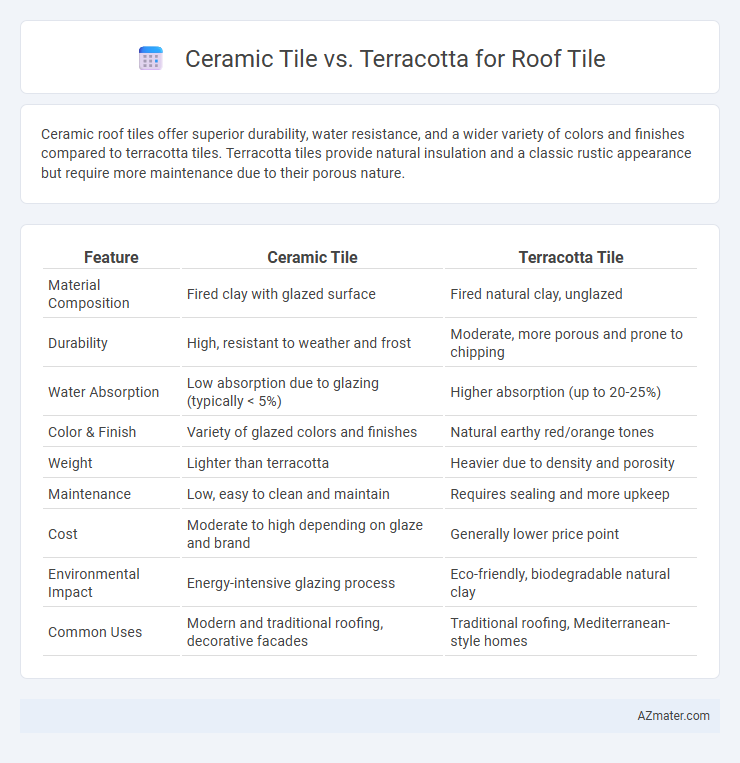Ceramic roof tiles offer superior durability, water resistance, and a wider variety of colors and finishes compared to terracotta tiles. Terracotta tiles provide natural insulation and a classic rustic appearance but require more maintenance due to their porous nature.
Table of Comparison
| Feature | Ceramic Tile | Terracotta Tile |
|---|---|---|
| Material Composition | Fired clay with glazed surface | Fired natural clay, unglazed |
| Durability | High, resistant to weather and frost | Moderate, more porous and prone to chipping |
| Water Absorption | Low absorption due to glazing (typically < 5%) | Higher absorption (up to 20-25%) |
| Color & Finish | Variety of glazed colors and finishes | Natural earthy red/orange tones |
| Weight | Lighter than terracotta | Heavier due to density and porosity |
| Maintenance | Low, easy to clean and maintain | Requires sealing and more upkeep |
| Cost | Moderate to high depending on glaze and brand | Generally lower price point |
| Environmental Impact | Energy-intensive glazing process | Eco-friendly, biodegradable natural clay |
| Common Uses | Modern and traditional roofing, decorative facades | Traditional roofing, Mediterranean-style homes |
Introduction to Roof Tile Materials
Ceramic tiles, made from refined clay and fired at high temperatures, offer durability, water resistance, and a wide range of aesthetic finishes ideal for modern roofing. Terracotta roof tiles, crafted from natural clay with a distinctive reddish hue, provide excellent thermal insulation and a timeless, rustic appearance popular in traditional Mediterranean architecture. Both materials excel in weather resistance, but ceramic tiles generally feature enhanced glazing for superior longevity and color retention.
What is Ceramic Tile?
Ceramic tile is a durable roofing material made from natural clay that is molded and fired at high temperatures to achieve strength and water resistance. It offers superior longevity, color retention, and low maintenance compared to traditional roofing options. Its glazed surface helps protect against moisture and weather damage, making it an ideal choice for long-lasting roof tiles.
What is Terracotta Tile?
Terracotta tiles are traditional roofing materials made from natural clay fired at lower temperatures, resulting in a porous, reddish-brown appearance renowned for its rustic charm and thermal insulation properties. Unlike ceramic tiles, which undergo higher temperature firing and often feature glazed finishes, terracotta preserves natural breathability and durability, ideal for Mediterranean and rustic architectural styles. Their distinctive earthy tones and texture provide excellent weather resistance and energy efficiency, making terracotta a sustainable roofing choice suited for warm climates.
Aesthetic Differences: Ceramic vs Terracotta
Ceramic roof tiles offer a smooth, glazed finish with vibrant color options that resist fading, providing a sleek and polished appearance. Terracotta tiles feature a natural, earthy texture with warm reddish-brown tones that develop a unique patina over time, enhancing rustic charm. The choice between ceramic and terracotta significantly impacts the visual character of a roof, balancing modern elegance against traditional warmth.
Durability & Lifespan Comparison
Ceramic roof tiles offer superior durability with resistance to frost, fire, and impact, typically lasting 50 to 100 years, while terracotta tiles, made from natural clay, provide excellent thermal insulation but generally have a shorter lifespan of 30 to 50 years due to their porous nature. Ceramic tiles are often glazed or treated, enhancing water resistance and reducing maintenance needs compared to terracotta's unglazed, more vulnerable surface. Terracotta's durability can be compromised in freeze-thaw cycles, whereas ceramic tiles maintain structural integrity longer under varying climatic conditions.
Weather Resistance and Performance
Ceramic tiles exhibit superior weather resistance due to their glazed surface, offering enhanced protection against rain, frost, and UV radiation compared to terracotta tiles, which are more porous and prone to water absorption. Terracotta roof tiles provide excellent thermal insulation but may suffer from erosion or cracking in extreme weather conditions, reducing their overall durability. Ceramic tiles generally outperform terracotta in longevity and maintenance, making them a preferred choice for harsh climates.
Maintenance Requirements
Ceramic roof tiles require minimal maintenance due to their dense, non-porous surface that resists moisture and mold growth, reducing the need for frequent cleaning or repairs. Terracotta tiles, made from natural clay, are more porous and may need regular sealing to prevent water absorption and cracking, especially in harsh weather conditions. Proper maintenance of terracotta involves periodic inspections for chips or cracks and applying protective coatings to extend their durability.
Environmental Impact & Sustainability
Ceramic roof tiles, made from refined clay and fired at high temperatures, offer greater durability and lower maintenance, resulting in an extended lifespan that reduces environmental waste compared to terracotta. Terracotta tiles, crafted from natural clay and fired at lower temperatures, have a smaller carbon footprint during production but are generally less durable, leading to more frequent replacements. Both materials are recyclable and biodegradable, but ceramic tiles typically outperform terracotta in longevity and resistance to weathering, promoting long-term sustainability in roofing.
Cost Comparison: Ceramic vs Terracotta
Ceramic roof tiles generally cost more upfront than terracotta tiles due to their manufacturing process and enhanced durability. Terracotta tiles offer a more affordable initial investment but may require more maintenance over time, potentially increasing long-term expenses. The price difference typically ranges from 20% to 40%, influenced by factors like tile thickness, finish, and installation complexity.
Choosing the Right Roof Tile for Your Home
Ceramic tiles offer superior durability and resistance to weathering, making them ideal for homes in regions with variable climates, while terracotta tiles provide excellent thermal insulation and a distinctive, rustic aesthetic that suits Mediterranean-style architecture. Terracotta's porous nature requires proper sealing to prevent moisture absorption, whereas ceramic tiles tend to have lower water absorption rates, enhancing their longevity. When choosing the right roof tile for your home, consider factors like climate, architectural style, maintenance needs, and budget to ensure optimal performance and visual appeal.

Infographic: Ceramic Tile vs Terracotta for Roof Tile
 azmater.com
azmater.com